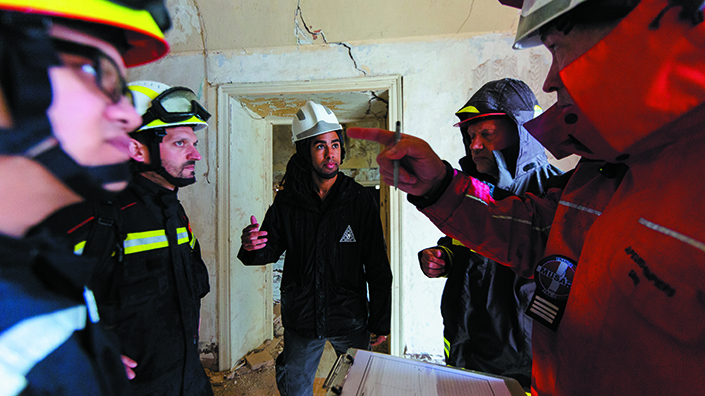Articles
Even as we speak about his latest engineering adventures, he’s exploring a forest near his home in Bishop’s Stortford, Hertfordshire. The snow crunches under his feet and the phone signal keeps breaking but Joshua pushes on. His life, both personal and professional, has been a journey. Each experience has widened his perspective and taught him valuable lessons about his niche: disaster risk engineering.
Search and rescue
The 36-year-old has worked with so many organisations that deciphering their acronyms (USAR, EEFIT, INSARAG, EWB) should be the subject of a PhD thesis. Joshua’s got his PhD. He’s done television, guest lectures, is part of the This is Engineering campaign (led by the Royal Academy of Engineering) and is raising two young children. At the moment, he’s doing a lot of work with the World Bank. He’s also worked with the search-and-rescue charity SARAID, assembling teams to help countries deal with the aftermath of earthquakes, tsunamis and other disasters.
“I try to focus on doing something that’s in some way useful to someone,” says Joshua. “With engineering, there’s a very tangible, real-world output that impacts people’s lives. Working in disasters amplifies that. It’s technically very challenging and intellectually interesting.”
Joshua grew up in Romford, Essex, studied to become a structural engineer and decided to spend a year volunteering abroad. He landed up on the southern tip of Africa, in a rural community where a government office is a Portakabin and the poverty is extreme. He helped deliver basic services like water and homes. The work was tough, the suffering was everywhere and he found it difficult to switch off. But, at the same time, he discovered how resilient people can be and how much love and laughter exists even in hardship.

Joshua Macabuag with structural engineers undergoing disaster relief training
After coming back to England, Joshua worked in building design and became a chartered engineer. He kept being drawn to disaster work, particularly assessing structural damage, which kicks in once search-and-rescue efforts wind down.
Over the years, he experienced sharp contrasts in how different nations cope with disasters. He witnessed the devastation of the 2011 tsunami in Japan, the 2019 earthquake in Albania, and last year’s harbour explosion in Lebanon.
He remembers working in Nepal with SARAID after an earthquake in 2015, having to tell a family their home was too damaged to live in and that they would have to find new shelter. Or, during the same deployment, assessing a hospital and giving staff the green light to bring patients back inside the building. As he left, he could see beds being wheeled in from the lawn. Nepal was struck by major aftershocks so Joshua’s work proved critical.
The path to rebuilding
With each trip he got a clearer picture of how damage is assessed, risk is managed and how the path to rebuilding begins. He calls it his “journey of understanding”. It included seeing, first-hand, the difference between the damage brought by an earthquake (sporadic) and a tsunami (clear lines drawn by the water). Joshua realised how much was involved in planning for disasters and dealing with their aftermath – how many families need to know whether their homes are safe, and how many hospital wards must be inspected.
“There can be tens of thousands of buildings affected by a disaster,” explains Joshua. “We can look at a few, but the problem is a lot bigger.”
Two years ago, Joshua became a freelance consultant. This, he hopes, will give him more space to focus on his passion: bringing together people interested in disaster risk engineering to make an even bigger impact. “It doesn’t have to be world-changing impact,” he says. “It’s about making sure that what you do makes a small difference to someone. And engineers have a great opportunity to do that.”
Want the best engineering stories delivered straight to your inbox? The Professional Engineering newsletter gives you vital updates on the most cutting-edge engineering and exciting new job opportunities. To sign up, click here.
Content published by Professional Engineering does not necessarily represent the views of the Institution of Mechanical Engineers.